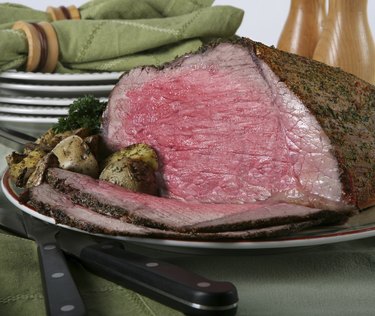
Beef roasts come in several different types, from areas all over a side of beef. Choosing just the right one for a dinner or gathering can be a little confusing. Chuck and bottom round roasts are from opposite ends of the animal, and are two types that are commonly used.
Chuck Roast
Video of the Day
The chuck area of cattle is located around the shoulders and includes ribs 1 through 5, as well as the shoulder blade bone. The ribs begin counting from the head and work down toward the tail. Chuck roasts generally have quite a bit of connective tissue and do well with a slow, moist style of cooking to break it down.
Video of the Day
Round Roast
The round area is located near the butt and back leg. Aside from the bottom round roast, the round includes the top round roast and eye of round roast. Round roasts often are tender enough to roast, but braising is still the preferred way to keep the roasts moist and tender.
Chuck Roasts
The chuck section of the beef contains several different types of roast. The top blade roast is broad and flat; the chuck 7-bone is characterized by a bone that looks like the number 7; the bottom chuck has quite a lot of fat and connective tissue; the chuck shoulder can be chewy; and the chuck eye is a boneless cut from the middle of the first five ribs, and is higher in fat. Fatty chuck roasts are good to roast, as the marbling inside helps keep them moist. Chuck roasts that have tougher, connective tissue that should be braised in liquid to avoid a chewy piece of meat at the end.
Bottom Round Roasts
The bottom round roast comes from the outside muscle of the upper hind leg and usually is rather lean. Slow cooking in liquid will help keep the bottom round moist and add flavor, as it is somewhat bland. If you don't want to cook the bottom round as a whole roast, cut it into thin slices against the grain and use it for Asian stir-fry recipes.
Considerations
Always allow a roast to rest after it has finished cooking so the meat juices go back into the meat and not on the cutting board. Cook each type of roast to an internal temperature of 145 degrees Fahrenheit for medium-rare and 160 degrees Fahrenheit for medium. Well-done chuck or round roasts may be chewy, but if you still want it cooked that way, wait until the internal temperature is 170 degrees Fahrenheit. Slice any visible fat off the roasts before cooking to lower the overall fat content.